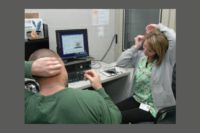Managing music volume at work: Implement a personal listening device policy

Disadvantages of PLD use
On the one hand, listening to PLDs can be distracting, increase the risk for noise-induced hearing loss and tinnitus, decrease situational awareness or create increased safety risk (cords in machinery, etc.). However, these risks can sometimes be mitigated with proper use of PLDs. Safety professionals should consider a policy regarding the use of PLDs in the workplace.
Advantages of PLD use
Studies show that listening to music can relieve stress, relieve tedium and even mask tinnitus (ringing in the ears). For workers whose day is filled with repetitive tasks or monotonous work, listening to PLDs can keep some workers stimulated and more productive. For workers who currently use radios or speakers that might disrupt other workers, PLDs can keep harmony in the workplace and even decrease the exposure levels. Listening to self-selected audio has been shown to increase morale. Hearing protection designed to provide safe listening levels may even motivate workers to use hearing protection. Refer to Sidebar 1 for quotes from users of PLDs and Figure 1 for an informal survey of where users of one type of personal listening earmuff use the PLD.
Regulatory guidance
OSHA allows use of these devices in certain situations. In a letter of interpretation published in 1987 regarding the “Use of walkman radio, tape or CD players and their effect when hearing protection is in use,” OSHA states:
“…special ear muffs equipped with volume-limited music for use in monotonous high noise jobs to protect employee hearing but at the same time allowing them to enjoy background music…..are in compliance with OSHA regulations if they meet the attenuation requirements relative to the workplace noise levels and their average music output is less than 90 dBA.”
“Use of Walkmen in noise environments in excess of Tables G-16 and D-1 is a violation. Use of Walkmen over required ear protection is a violation. Use of Walkmen in occupational noise less than Tables G-16 or D-1 is at managerial discretion unless its use causes a serious safety hazard to warrant issuance of a 5(a)(1). Management and employees must be made aware that Walkmen type devices do pose a hazard to hearing if they are played too loud for any significant length of time, whether on or off the job.”
The full letter of interpretation is available on osha.gov.
The European Commission (the executive body of the European Union (EU)) asked its scientific advisory panel, the Scientific Committee on Emerging and Newly Identified Health Risks (SCENIHR), to provide guidance regarding whether current directives and standards were adequate in light of the increased use of PLDs (referred to in the report as personal music players (PMPs)). The SCENIHR concludes that although a certain proportion of users increase their risks, listening at levels below 80 dBA can be considered safe.
How to use PLDs responsibly
A comprehensive policy will need to differentiate between office environments, mobile (driving) environments and production environments. Listeners tend to increase the volume over background sound. If PLD are to be allowed in hazardous noise environments, it is vital to ensure sound isolation with appropriate earmuffs or ear buds that are designed for safe use of PLDs.
Consider all the noise sources — PLD levels over 80 dB should be integrated into the calculations for employees’ Time Weighted Average exposure level.
Manage Your Maximum Volume — In the control panel of most MP3 players and portable listening devices, there is a function that enables the user to lower the maximum volume level to lower than the default factory setting. (On Apple products: Go to Settings > Music > Volume Limit; see your User Manual for Output Limit on your device) If PLD are allowed, help users understand the responsibility of safe listening.
Give Your Ears a Break — After listening to loud music (or noise) for any period of time, the receptor nerve cells in your cochlea need a rest. They’ll need time to rest and refresh before they are exposed to additional noise (at safe, protected levels).
Use a product that is designed to protect as well as provide audio output. Manufacturers of hearing protection are a good source for information as well as products.
Listening levels can be monitored with the use of a “Jolene” manikin, a system for measuring the sound levels of personal listening devices if you want a higher level of assurance regarding the level at which employees are listening. Jolene was designed and constructed using a used fashion mannequin and a sound level meter wired to a silicone ear. http://www.dangerousdecibels.org/education/jolene/cookbook/
Personal Listening Devices can be a part of some workplaces but should be addressed in the safety plan.
Looking for a reprint of this article?
From high-res PDFs to custom plaques, order your copy today!




